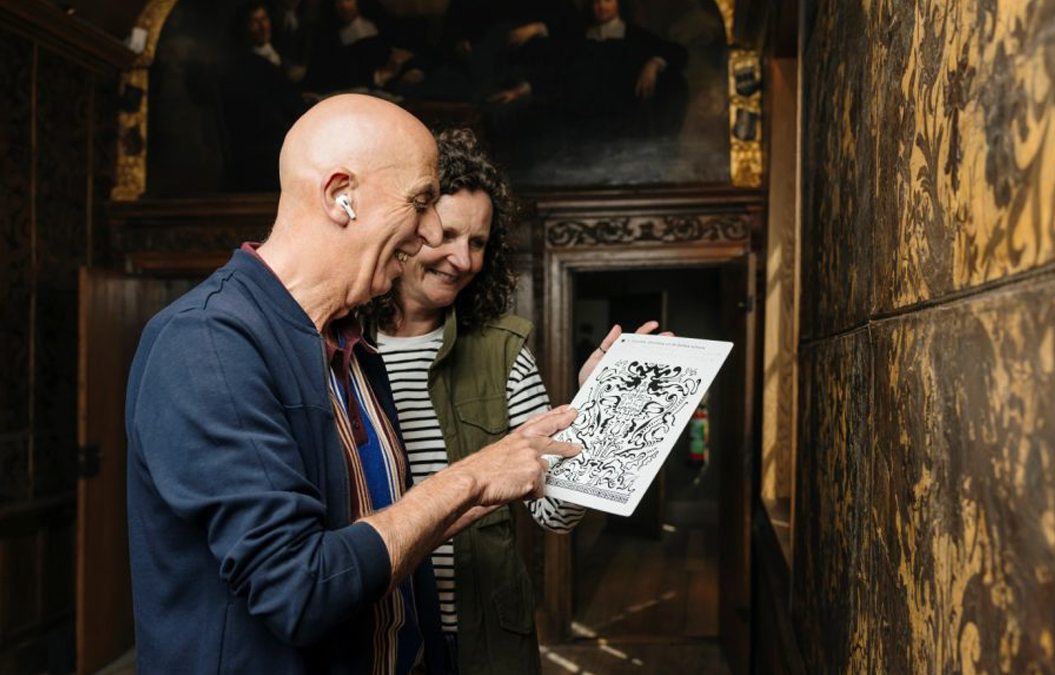An independent visit to a museum can be quite a challenge for people with a visual impairment. That is why Museum De Lakenhal developed an audio tour especially for this target group, which tells you everything about the museum and its building. The tour can be followed independently at any time.
Museum building as a collection item
The audio tour, titled Looking with your fingers – the museum building tells the story about the largest and most important collection item of Museum De Lakenhal: the museum building. It is a unique place, where Leiden cloth was inspected from 1640, and which now houses the city museum of Leiden. The tour allows for a self-guided visit with a sighted guide, at your own time and at your own pace. In this way, an independent museum visit is possible for everyone.
Tactile materials
In the tour, visitors are guided past special places in the building. Users not only get the chance to hear the stories behind these locations: they are also allowed to touch the walls, furniture and banisters. Where the collection is too fragile to touch, special tactile materials are available. Think, for example, of tactile drawings, a 3D print of the facade and a model on which the map of the museum has been made tangible. These materials have been developed in collaboration with the CBB and Visual First .
Free with the app
The tour is free for everyone to follow via the Lakenhal app, which you can download on your own iOS or Android phone. In preparation for the launch of the tour, the interface of the existing app has been optimized so that visually impaired people can use the app in combination with the accessibility settings on their phone. The tour is written for people with a visual impairment, but is just as interesting for sighted people to follow: it is enriching for everyone to experience a museum visit with all your senses.
Feel at home
The tour is an important step in making the museum accessible to people with a visual impairment. Museum De Lakenhal believes it is important to take these steps to make everyone feel at home in the museum, including people for whom a museum visit is not self-evident. ‘Accessibility starts with the realization that the limitations people experience are not just their limitations,’ says Tanja Elstgeest, director of Museum De Lakenhal. ‘We see it as our responsibility to remove as many barriers as possible that could hinder people during their museum visit. In this way we want to ensure that as many people as possible can enjoy art.’
Very important
About 300,000 Dutch people live with a visual impairment. Of these, approximately 200,000 people are (severely) visually impaired and 50,000 are blind. For this group, the development of an audio tour like this is of great importance, agrees Joost van Gent, member of the focus group that helped develop the audio tour. “I have been able to see for 52 years, but am now visually impaired. This audio tour allowed me to really experience the museum and to get a good idea of how the building has changed compared to the past. Very special!”
Accessibility at De Lakenhal museum
The audio tour is not the first step that Museum De Lakenhal has taken to improve the accessibility of the museum. Most of the building is accessible to people with reduced mobility. Guided tours are also provided in Dutch Sign Language for the deaf and hard of hearing, and there are tours and workshops for people with dementia and their loved ones. More information can be found on the website of Museum De Lakenhal .
Partners and funds
The tour has been developed in close collaboration with Mikxs , Stichting Oren en Ogen Tekort and people with a visual impairment. The audio tour was made possible thanks to a generous contribution from the RAAK Incentive Award , a close partnership between the Eye Association , Stichting Accessibility/Bartiméus and Koninklijke Visio , and was made possible in part by joint funds in the field of vision.
